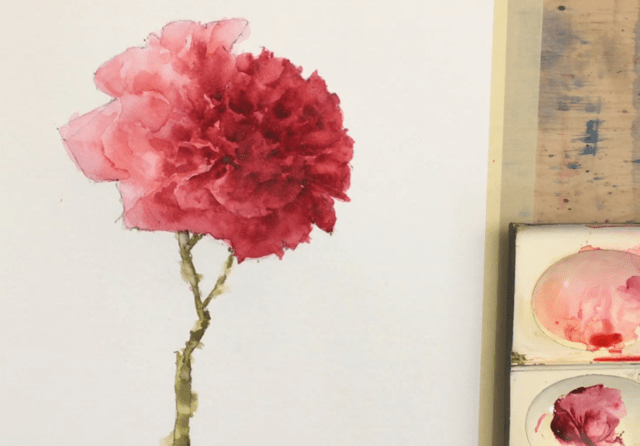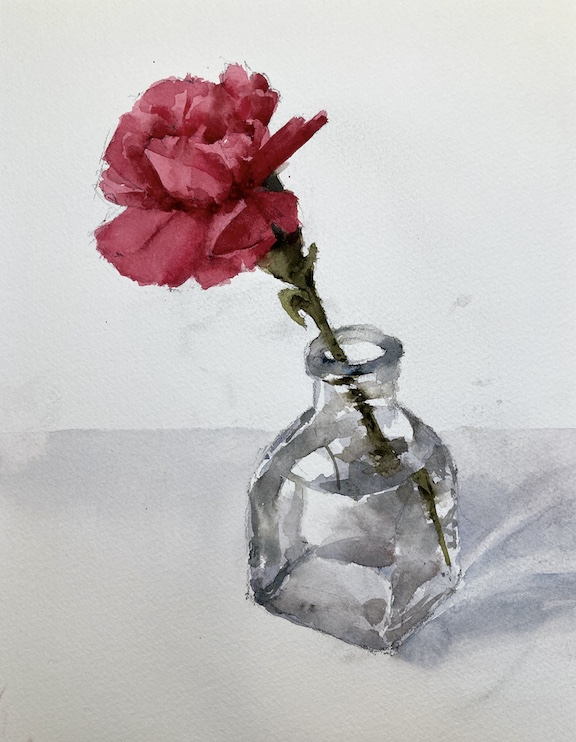Watercolor flower painting can be so rewarding. And if you’re looking for flower painting ideas a carnation watercolor is great way to start. Such beautiful colors and lots of twiddly crinkly petals that catch the eye. However, it doesn’t mean they’re easy. As with all flowers we have to get the colors right both in the light and the shadow and we have to get the shadows in the right places. Maybe most importantly we have to pay attention to the edges. All those crinkles! We want to suggest them in our painting but not detail every last one. A perfect subject for a watercolor painting!
Carnation Watercolor
Watercolor Carnation Tutorial steps
This is one of my step by step watercolor lessons on painting a single carnation. When you start to paint watercolor flowers it’s good to take it slow and follow step-by-step. I take you through identifying the values and mixing the colors. We will then move onto painting the major shapes and then adding in the detail. A lot of the hard work is in the prep and mixing. If we get all that right the details often go in very quickly.
Materials Needed
- Mechanical pencil
- Watercolor paper (I like Fabriano Artistco)
- Size 10 round sable or synthetic sable
- Permanent rose
- Vermillion/pyrrole red/naphthol red
- Lemon yellow
- Burnt Sienna
- Black
- Value Scale
- Color isolator
- Palette/paper towels/water pot
- A solid resolve
How to start painting a watercolor carnation
So how should we think about this watercolor painting? I like to start by first looking at the overall shape and how the light falls on the flower. Which direction is the light coming from? Where on the bloom does it fall into shadow?
Simplify the carnation flower
If we ignore all the little crinkly petals a carnation is pretty spherical. It’s a lot simpler in structure than a watercolor rose (which is a whole different tutorial). And in our reference the light is coming from the left. So the left side of our flower is in the light and the right side is in the shadow. If we strip it back to this we have one color in the light and one color in the shadow. Of course there will be differences in the details. In the deep crevices of the petals it will go darker and some of the outer edges will catch the light. But let’s start there and get those colors right. When you’re working out how to paint a carnation simplifying the basic colors needed is a vital first step.
Use your value scale to find the values of the light and the shadow
We have a pink carnation and you can pretty easily see we have a light pink on the light side and a darker pink on the shadow side. But how light and dark are they? And how can we mix them? It’s a good idea to break out your color isolator and your value scale here.
If you’re working from a printed reference then you can place them directly over the print. I actually recommend this if you’re just starting out with painting or if you’re working on nailing those values. If you’re working from life you can hold them up in front of the flower but be careful! Make sure the light falling on your value scale or isolator is the same as is falling on your flower. If you have your flower backlit you won’t get an accurate reading.
Squinting your eyes helps with values
What makes this slightly tricky with a bright pink flower is that we only have a grey value scale. The best way to cope with this is place your value scale on your reference and squint your eyes. The squinting will take the color out of what you’re looking at and make it easier to judge value. Eventually you’ll be able to make a pretty accurate guess but it’s always useful to check. Move the value scale along the region you’re looking at (pick an ‘average’ region) and find the value where the edge and the region almost merge together. It probably won’t be an exact match but you’ll be able to narrow it down to within a step. Do this for both the light side and the shadow. For my reference I get a value 6 in the light and a value 2 in the shadow.
Make some color swatches
Now I’m going to say something heretical here. Don’t sweat the precise color of the swatches you’re going to make. But really sweat the value! Try and really nail that value.
How to mix pinks in watercolor
So where do we start with color. We know our flower is pink and we have a pinkish red on the palette. I always start with which color on my palette is closest to the one I want to mix. I have two reds on my palette – an orangey red (vermillion) and a pinkish red (permanent rose). We know it’s definitely pink so permanent rose it is.
Pay attention to paint consistency when mixing value
The really annoying thing about watercolor painting is that when we mix colors on the palette they look *nothing* like the colors that end up on the paper. They always look darker until they get placed on the paper and are spread so thin that the paper shines through.
So what should we do? Well we could just test a swatch on some scrap paper and that is always a good idea to check. But while we’re on the palette all we really have to go on is the consistency of the paint. We add water to make a pigment lighter so the consistency of the paint gets thinner. Dark paint – thick paint and light paint – thinner paint. When we’re planning our watercolor carnations painting pay attention to both – the consistency of the paint and how it looks on your scrap paper.
Mix the light value for the carnation watercolor
For our value 6 our paint needs to be roughly of the consistency of 2% milk. It will flow around the palette fairly easily. For comparison a value 5 will be light cream consistency and darker will be heavy cream. Try mixing your permanent rose with some water until it feels like a milk consistency. Then try a swatch on some scrap paper. Let it dry a little (watercolor always dries lighter) and bring in your value scale to see how close you are.
Practice makes mixing much easier
This seems like a really awkward process when you first start. And we haven’t even started putting paint on the paper yet! But it gets a lot easier very quickly. And trust me – your paintings will get so much better very quickly. The ability to mix accurate values is a key skill towards getting an effective watercolor.






















